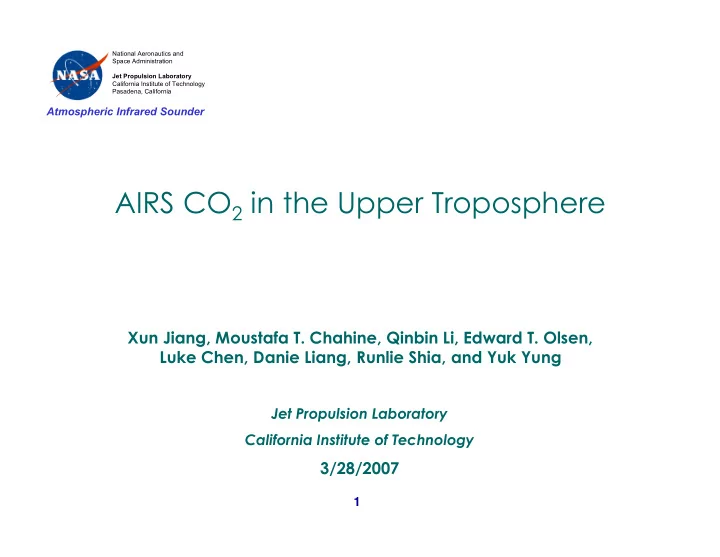

National Aeronautics and Space Administration Jet Propulsion Laboratory California Institute of Technology Pasadena, California Atmospheric Infrared Sounder AIRS CO 2 in the Upper Troposphere Xun Jiang, Moustafa T. Chahine, Qinbin Li, Edward T. Olsen, Luke Chen, Danie Liang, Runlie Shia, and Yuk Yung Jet Propulsion Laboratory California Institute of Technology 3/28/2007 1
National Aeronautics and Space Administration Jet Propulsion Laboratory California Institute of Technology Overview Pasadena, California Atmospheric Infrared Sounder Motivation Validation of AIRS CO 2 and O 3 with Aircraft and Ozonesonde Data Stratospheric Sudden Warming Influence on CO 2 and O 3 Model Comparisons 2
National Aeronautics and Space Administration Jet Propulsion Laboratory California Institute of Technology Motivation Pasadena, California Atmospheric Infrared Sounder Trace gases from AIRS offer a unique opportunity to test chemical/transport/dynamical models Improve our understanding of stratosphere-troposphere exchange and vertical transport in the models 3
National Aeronautics and Space Administration Jet Propulsion Laboratory California Institute of Technology Data Pasadena, California Atmospheric Infrared Sounder AIRS CO 2 and O 3 in Upper Troposphere Aircraft Data of CO 2 from Matsueda et al . [2002] and Climate Monitoring & Diagnostics Laboratory (CMDL) Ozonesonde data from World Ozone and Ultraviolet Data (WOUDC) 4
Models 2-D Caltech/JPL Chemistry and Transport Model (CTM) 10° (latitude); 40 vertical levels Transport: NCEP and UKMO Reanalysis Data Boundary condition: CMDL CO 2 3-D GEOS-CHEM Model 2° (latitude) x 2.5° (longitude), 30 vertical levels Transport: GEOS–4 Meteorological Data GEOS–3 Meteorological Data Boundary condition: CMDL CO 2 CO 2 surface sources and sinks MOZART2 Transport: MACCM3 Boundary condition: CMDL CO 2
National Aeronautics and Space Administration Comparison Between AIRS CO 2 with Jet Propulsion Laboratory California Institute of Technology Pasadena, California Matsueda Aircraft Data Atmospheric Infrared Sounder SD: -1.14 ± 1.44 ppmv CO 2 retrieved by Vanishing Partial Derivatives (VPD) Chahine et al. [2005, GRL] 6
Version 5 AIRS CO 2 · Matsueda CO 2 aircraft data · CMDL CO 2 aircraft data —— Version 5 AIRS CO 2 —— Count of Clusters —— CJCTM 2D (CMDL BC) —— GEOS-Chem 3D (CMDL BC) —— GEOS-Chem 3D (Source/Sink) —— MOZART2 (CMDL BC)
Version 5 AIRS CO 2 Jan Apr Jul Oct · Matsueda CO 2 aircraft data · CMDL CO 2 aircraft data —— Version 5 AIRS CO 2 —— Count of Clusters —— CJCTM 2D (CMDL BC) —— GEOS-Chem 3D (CMDL BC) —— GEOS-Chem 3D (Source/Sink) —— MOZART2 (CMDL BC)
Version 5 AIRS O 3 · Ozonesonde Data —— Version 5 AIRS O 3 —— Count of Clusters —— CJCTM 2D —— GEOS-Chem 3D —— J. Logan O 3 Climatology
Version 5 AIRS O 3 Apr Jan Jul Oct · Ozonesonde Data —— Version 5 AIRS O 3 —— Count of Clusters —— CJCTM 2D —— GEOS-Chem 3D —— J. Logan O 3 Climatology
Northern Hemisphere Stratospheric Sudden Warming —— Zonal Wind at 60N —— Zonal Wind at 60N-80N - - - Temperature at 60N-90N Apr Jan Feb Mar Stratospheric Major Warming Criteria: averaged 60-80ºN zonal mean winds and 60ºN zonal mean wind reverse sign [ Manney et al ., 2005]. It has important influence on the chemical tracers.
Influence of Sudden Warming on CO 2 and O 3 —— Zonal Wind at 60N —— Zonal Wind at 60N-80N - - - Temperature at 60N-90N —— AIRS Retrieved CO 2 —— AIRS Retrieved O 3 25% Apr 6 Apr 14 Apr 20 AIRS retrieved upper tropospheric CO 2 increases while AIRS 300 mb O 3 decreases following a sudden stratospheric warming event
Comparison of Model CO 2 with Matsueda Aircraft Data · Matsueda CO 2 aircraft data
Comparison of Model CO 2 with Matsueda Aircraft Data · Matsueda CO 2 aircraft data —— GEOS-Chem 3D (CMDL BC) —— GEOS-Chem 3D (Source/Sink) —— GEOS-Chem 3D; GEOS-3 (CMDL BC)
Comparison of Model CO 2 with Matsueda Aircraft Data · Matsueda CO 2 aircraft data —— GEOS-Chem 3D (CMDL BC) —— GEOS-Chem 3D (Source/Sink) —— GEOS-Chem 3D; G-3 (CMDL BC) —— CJCTM 2D (CMDL BC) —— MOZART2 (CMDL BC)
Comparison of Model CO 2 with AIRS CO 2 · Matsueda CO 2 aircraft data —— GEOS-Chem 3D (CMDL BC) —— GEOS-Chem 3D (Source/Sink) —— GEOS-Chem 3D; G-3 (CMDL BC) —— CJCTM 2D (CMDL BC) —— MOZART2 (CMDL BC) · Version 5 AIRS CO 2
· Matsueda CO 2 aircraft data —— GEOS-Chem 3D (CMDL BC) —— GEOS-Chem 3D (Source/Sink) —— GEOS-Chem 3D; G-3 (CMDL BC) —— CJCTM 2D (CMDL BC) —— MOZART2 (CMDL BC) · Version 5 AIRS CO 2
Vertical Transport in Models · Matsueda CO 2 aircraft data —— GEOS-Chem 3D (CMDL BC) —— GEOS-Chem 3D (Source/Sink) —— GEOS-Chem 3D; G-3 (CMDL BC) —— CJCTM 2D (CMDL BC) —— MOZART2 (CMDL BC) · Version 5 AIRS CO 2
Sensitivity Studies Effect of Turbulence Effect of Deep Convection Mixing in PBL Updraft Mass Flux
National Aeronautics and Space Administration Jet Propulsion Laboratory Conclusions California Institute of Technology Pasadena, California Atmospheric Infrared Sounder The latitudinal distribution of AIRS retrievals of upper tropospheric CO 2 agrees reasonably well with model calculations and in situ aircraft observations of CO 2 from 50ºS to 50ºN. Model calculations and AIRS retrievals of CO 2 capture the seasonal cycle. AIRS retrieved O 3 at 300 hPa agrees reasonably well with ozonesonde measurements and model calculations. AIRS retrieved upper tropospheric CO 2 increases while AIRS 300 mb O 3 decreases following a sudden stratospheric warming event. The convective mass flux is crucial for the correct simulation of upper tropospheric CO 2. 20
National Aeronautics and Space Administration Jet Propulsion Laboratory California Institute of Technology Pasadena, California Atmospheric Infrared Sounder Thank you! 21
Recommend
More recommend